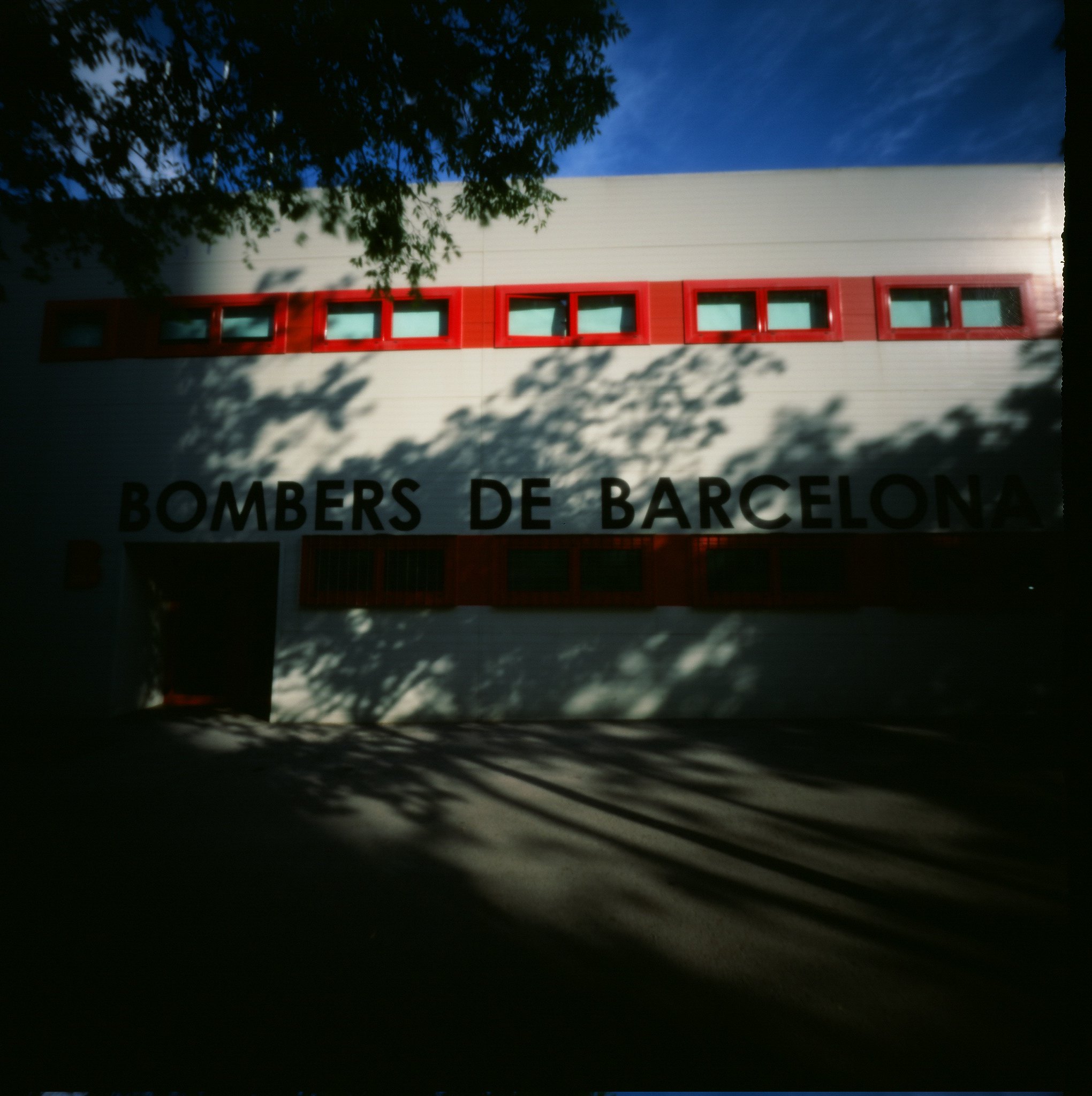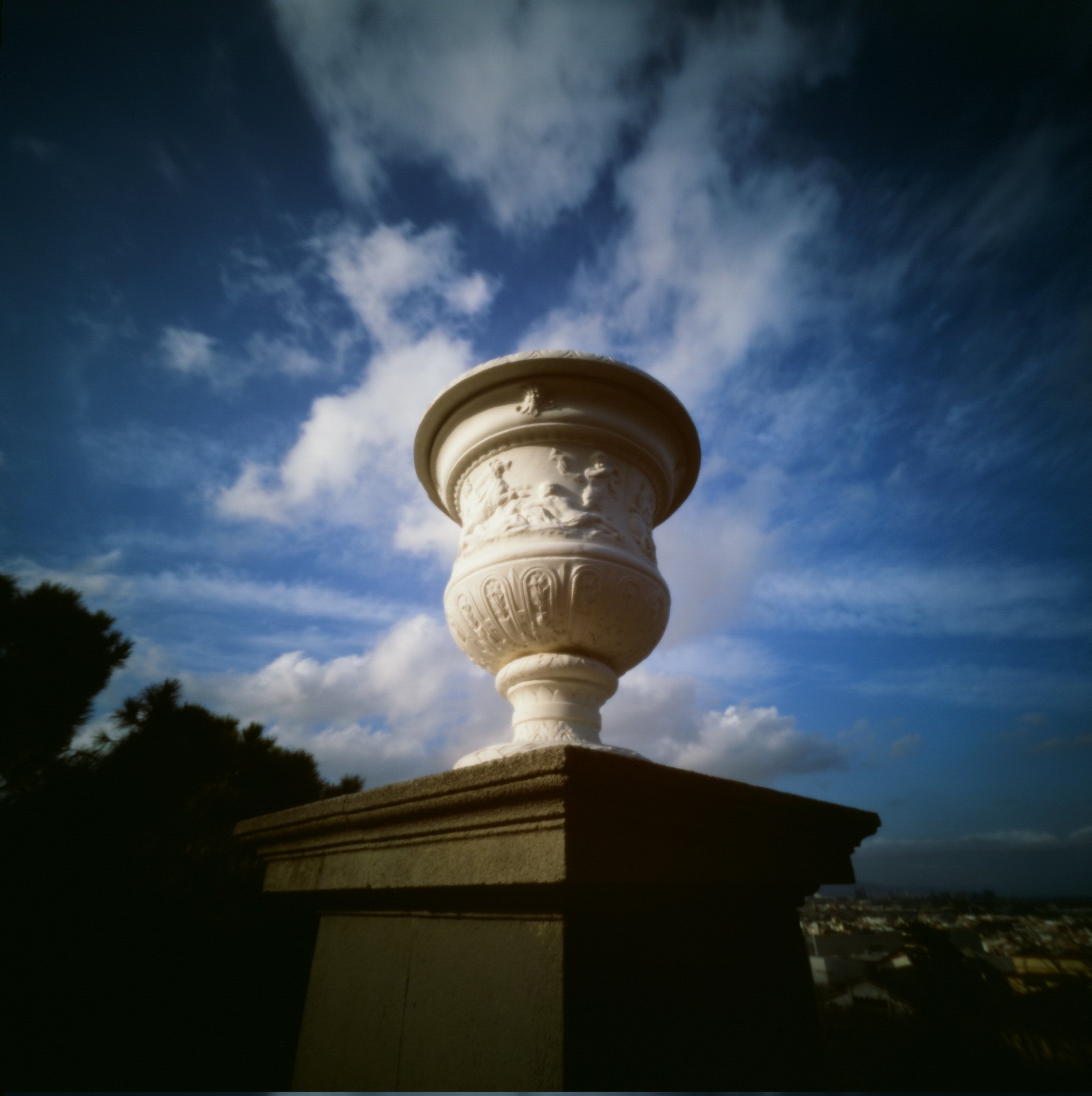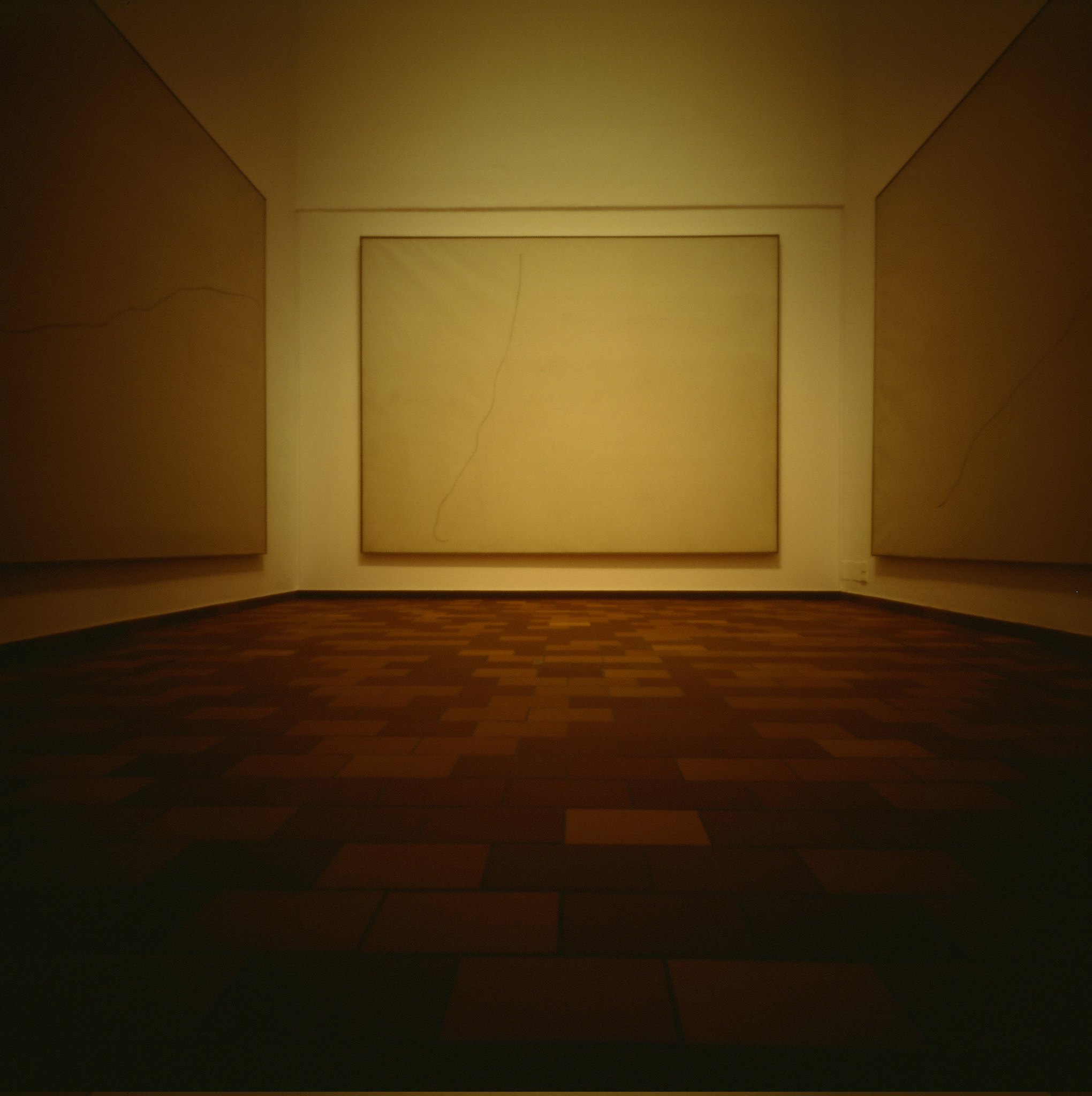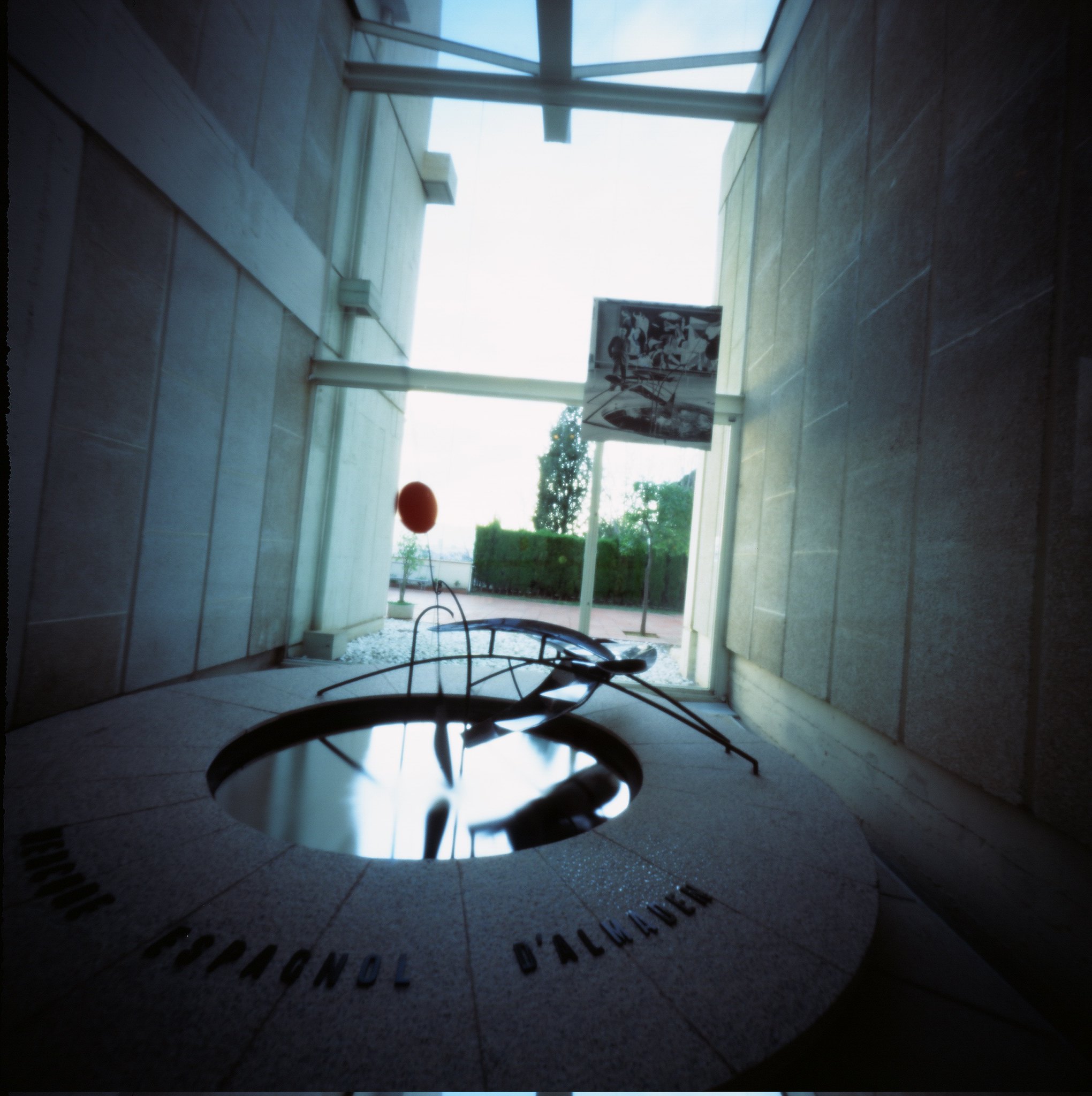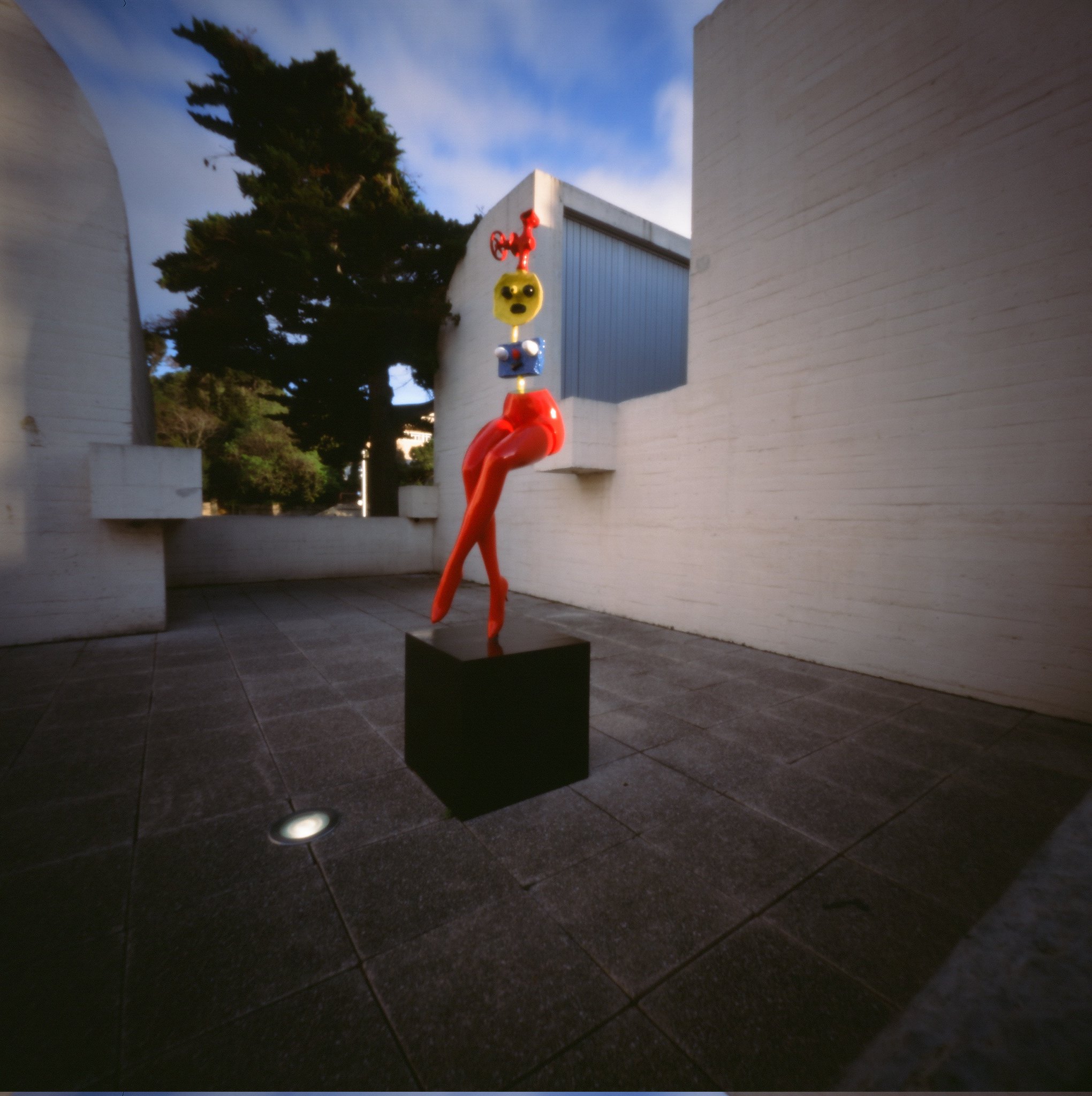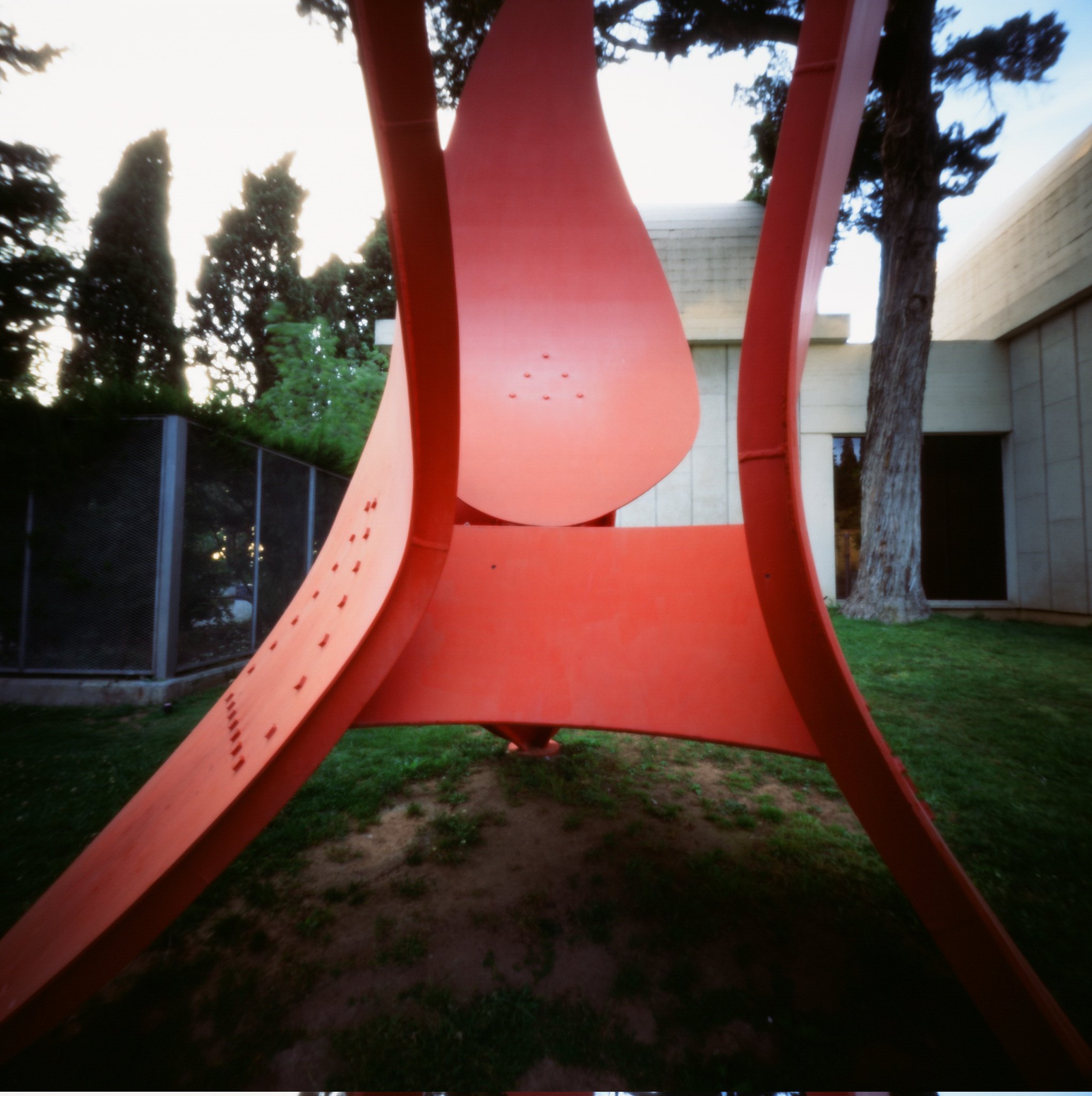Adventure is where you find it.
I have said this since I was a kid. I believe that adventure can be found anywhere! Adventure is something you can cultivate during a visit to a neighborhood park or travelling to a distant, exotic destination. Adventure often finds you when you dare to break out and try something new and unknown.
Beehive and I were in Barcelona for Worldwide Pinhole Photography Day last April, meeting up with more than 30 (pinhole) photographers from around the world. Having never been to Barcelona, we took every opportunity to strike out and explore new corners of the city. We typically took the subway to an distant destination, and then made the long walk back to our flat.
On this particular day, we had taken the train to the Montserrat Monastery and on our return trip decided we were not quite ready to call it a day. We got off the train at Espanya Station and rather than catch a subway connection, we climbed from the depths of the city to find ourselves in a new landscape, Plaça d'Espanya. We walked a little further, and found a modern fire station at the edge of the park. It was late in the afternoon and no activity was to be seen Probably still siesta time. I really wanted a Barcelona fire department t-shirt, but I didn't want to disturb anybody.
It's not a high hill, but the steps seem endless (there are actually escalators, but they weren't working) as you climb from the plain of Barcelona's streets and avenues. We paused to catch our breath and look out over the glorious city, and I shot this urn in the clouds.
Miró had an agenda of turning art on its ear and achieving an "assassination of painting", in the interest of promoting contemporaneous socio-political issues. In the context of his world, Miró was punk. He challenged accepted norms concerning art, design, and composition. He painted huge canvases with extremely subtle and fine linework in the interest of communicating his distress over Spanish politics. I sat for eight minutes, mulling his commitment, while my shutter was open.
Outside the museum, a characteristically red sculpture by Calder beckoned and I opened my shutter once again, this time on a proper tripod, seeking the contours and rivets that are common in his work. My mood eased and I felt at peace again.
We walked a little a little further and stumbled upon the funicular railroad that would take us down to the waterfront and from where we would continue our amble back to the flat. Here's some more information about the works at the Fundacio Joan Miró. ARTSY has a very informative page on Alexander Calder. Their mission is to make all the world's art accessible to anyone with an Internet connection. All photos made with the terraPin Prime 3Dprinted pinhole camera Shot on Fujichrome Velvia 50 film. |

An online gallery for my visual art, particularly pinhole film photography. Expect verbosity.
You can find my other stuff on the Internet:
twitter: @theschlem
terraPin Pinhole Cameras and other 3D Printing Designs
Flickr
My ETSY Shop
More Schlinks
Tuesday, May 31, 2016
"A Sandbox For The Subconscious Mind"
Sunday, May 15, 2016
Pinhole Photography Short & Sweet, a Mini Zine
I have my friend Hank to thank for the Body Snatcher idea of Zines, innocently planted in my brain during a recent breakfast. I've since been thinking a lot about a small run of a photo zine, featuring themed pinhole photos. This little pamphlet is the first of such things to be spawned by Hank's inspiration. I plan to include it with pinhole cameras that I send to people. It assumes some ignorance, and isn't really meant for experienced pinhole photographers. I like the idea of some small color photos printed on the reverse side. Stay tuned!
Here is the PDF of my minizine, Pinhole Photography Short & Sweet. For proper formatting, print the PDF at 100%.
It probably could benefit from a critical eye. I think I caught all the spelling errors, but if you have suggestions to make this a more useful document, let's hear 'em!
Friday, May 13, 2016
We Met In Iceland: A Love Story
Two short years ago, I convinced my wife, Beehive, to join me in a grand social media experiment. The plan was to travel to Amsterdam, meet up with other pinhole photographers, and watch the awesome happen. On Worldwide Pinhole Photography Day (WPPD).
This amazing convergence was concocted largely by Alex, a self-deprecating git from Norfolk, with help from Inge, a charming photographer from Rotterdam. The idea began as an off-handed suggestion on Twitter, growing like a baby as people signed up on the Eventbrite page. This was happening before my eyes, unfolding in tweets, with perfect timing for my attendance.
I work in civil service and I pick my vacation for the coming year every December. As luck would have it, everything - the grand scheme, the wife's support, the necessary days off - aligned like celestial orbs, portending a good trip and new friends. It felt like unstoppable destiny.
We met in Amsterdam, and, well, we had a blast. Everything was amazing - the city, the weather, the people, the food, the drink, everything! I remember it vividly, and I'd love to write more about it, but this is a love story that takes place elsewhere.
After our adventures in the Netherlands, we took the train under the channel and had some days in London, and then off to Reykjavik, Iceland. Beehive had been to London many times, but I had only been through the airport once. So, we stayed in the Portobello Road area, and hoofed it all over town, visiting museums, the Tower, and taking in an amazing performance of Titus Andronicus at Shakespeare's Globe, on the bank of the River Thames.
I had brought some film with me to Europe that I had never shot as pinhole before: Ilford black and white, and some Fuji Velvia 50 slide film. The reciprocity failure corrections for different film stocks vary widely, and I rely on the collective intelligence of the Internet for that data, in lieu of testing myself. So, shooting a new film on Pinhole Day was a bit of a gamble. In England I leaned on my old friends Acros and Ektar.
In Iceland, we rented a "three-door Jeep", a tiny Suzuki hardtop SUV, and drove a route called the "Golden Circle". We drove through the Þingvellir national park, the geothermally active valley of Haukadalur, which contains the geysers Geysir and Strokkur, and to the Gullfoss waterfall (meaning "golden falls"). I decided to try the Velvia 50.
I almost didn't make this photograph of the falls. We had hiked down to the falls in the bright May sun and gotten a bit damp from the spray. Back up in the parking lot, surrounded by the tour buses and milling Germans, the wind was chilling. The sun was bright, much brighter than I like for pinhole, meaning very fast exposures and potential for camera movement and unwanted blur. I loaded my pinhole camera with the RVP50, and screwed an ND filter onto the front. I was cold, the conditions were too bright, but I thought about how I very probably would never be here, in this amazing place, ever again. I left my wife in the Suzuki to warm up, and trudged up the path to an overlook.
I set up my Gorillapod and metered the scene. Even with the exposure stopped down by the filter, the shutter would only be open for a few seconds. Putting a filter in front of your pinhole requires absolute cleanliness unless you want dust to be visible in your infinite depth of field. It also prevented me from using the finger-in-front-of-the-pinhole trick to avoid disturbing the camera during shutter movement.
When I got back to the Suzuki, I had no idea if my exposure had worked. We drove off through a landscape that looked like Hawaii, eastern Washington state, and Alaska, sometimes all at once.
This amazing convergence was concocted largely by Alex, a self-deprecating git from Norfolk, with help from Inge, a charming photographer from Rotterdam. The idea began as an off-handed suggestion on Twitter, growing like a baby as people signed up on the Eventbrite page. This was happening before my eyes, unfolding in tweets, with perfect timing for my attendance.
I work in civil service and I pick my vacation for the coming year every December. As luck would have it, everything - the grand scheme, the wife's support, the necessary days off - aligned like celestial orbs, portending a good trip and new friends. It felt like unstoppable destiny.
We met in Amsterdam, and, well, we had a blast. Everything was amazing - the city, the weather, the people, the food, the drink, everything! I remember it vividly, and I'd love to write more about it, but this is a love story that takes place elsewhere.
 |
| Amsterdamp, my official entry WPPD14, P6*6, f/167, Ilford FP4, 02:00 |
I had brought some film with me to Europe that I had never shot as pinhole before: Ilford black and white, and some Fuji Velvia 50 slide film. The reciprocity failure corrections for different film stocks vary widely, and I rely on the collective intelligence of the Internet for that data, in lieu of testing myself. So, shooting a new film on Pinhole Day was a bit of a gamble. In England I leaned on my old friends Acros and Ektar.
In Iceland, we rented a "three-door Jeep", a tiny Suzuki hardtop SUV, and drove a route called the "Golden Circle". We drove through the Þingvellir national park, the geothermally active valley of Haukadalur, which contains the geysers Geysir and Strokkur, and to the Gullfoss waterfall (meaning "golden falls"). I decided to try the Velvia 50.
 |
| Gullfoss, P6*6, f/167, Velvia 50 (RVP50), 00:03 |
I set up my Gorillapod and metered the scene. Even with the exposure stopped down by the filter, the shutter would only be open for a few seconds. Putting a filter in front of your pinhole requires absolute cleanliness unless you want dust to be visible in your infinite depth of field. It also prevented me from using the finger-in-front-of-the-pinhole trick to avoid disturbing the camera during shutter movement.
When I got back to the Suzuki, I had no idea if my exposure had worked. We drove off through a landscape that looked like Hawaii, eastern Washington state, and Alaska, sometimes all at once.
 |
Back in Reykjavik, I continued to shoot the Velvia50, liking the slightly longer exposures in bright light.
|
 |
| We walked to the highest point in town, upon which stands the Hallgrímskirkja. A towering concrete church, it took 41 years to build and is designed to look like columnar basalt formations. An elevator takes you to the top of the church, for sweeping views of Reykjavik and the mountains beyond. |
 |
I visited the Sun Voyager, a harbor-side sculpture evoking a Viking longboat bent on explorations and discovery.
|
 |
| Reykjavik is home to a world-famous hot dog stand. Dating back to 1937, Bæjarins Beztu Pylsur has repeatedly been ranked the best place to get a hot dog in Europe and the world. The customers queuing for a wiener eyed me suspiciously as I twined my Gorillapod through a chain link fence and aimed my camera. In the fading light, I "acted natural" and pretended to talk on my phone during the lengthening exposure. |
 |
| HARPA is a multi-purpose concert and cultural hall on the Reykjavik waterfront. A glowing glass and steel structure, it houses both the symphony and the opera. |
 |
| Reflecting pools in front of the hall were mirror calm as the evening enfolded me. |
|
I returned to the apartment, disoriented and excited. I couldn't believe that it was almost midnight and I had been making pinhole photographs so late.
|
 |
The next morning, on our way to the airport, we scheduled a detour to the Blue Lagoon, a hydrothermal spa, conveniently situated to extract one last payment from tourists who would sip ten-dollar beers in the silica-rich water. The landscape is otherworldly, and the pool is ringed by volcanic rock that would cut your feet to ribbons if you chose to escape overland. Those same rocks hide the geothermal plant that supplies the hot water to the spa, but beneath the low clouds it was truly surreal. Again, I reminded myself that this might be a once-in-a-lifetime experience and I set up my camera before catching the bus to the airport.
When I finally got home and had my film processed, I realized my love for Fujifilm Velvia 50. I've been shooting it ever since. All photos made with the P6*6 3Dprinted pinhole camera, uncropped and as scanned without alteration.
|
Wednesday, May 11, 2016
Blogs Are Like Belly-Buttons
Everybody has one.
My first blog was about my experiences in the Fire Service, which morphed into an autobiographical writing project. Later, I started another blog to share my tech projects, but lost interest in both. I am currently involved in the 52rolls photography project, which is a photo blog. I'm a little bit behind in my posts, but I have ample fodder in the thirty rolls of film I shot in Spain recently.
Since my first blog, I have expanded my social media use, particularly Twitter, but recently also Instagram, sharing photography and science/tech projects and interests. There is a lot of cross-pollination in the Internets of schlem, with various and duplicated content, but this blog is about my photography, especially pinhole film photography. Despite a lifetime of photography and other artistic creativity, only recently have I really begun to self-identify as an "artist".
So I humbly offer this, my latest bloggy project, with best intentions and a realistic understanding of my abilities, goals, and commitment.
What are my goals for this blog? Glad you asked -
My pinhole camera designs have been widely featured and discussed in various media, always with my photos supporting the capabilities of my cameras. I'm at a point where I want to discuss my photography as much, if not more, than the cameras I make. I also want to promote film photography, and provide technical data on exposure where possible. If I use a photo created with a digital camera, I will label it as such. Otherwise, expect the specific film used, at a minimum. Additionally, film photos will be uncropped and as scanned, unless otherwise noted.
I have committed to the Flickr platform, and there I upload all my pinhole and other film. I don't, however, use Flickr to share much context or narrative on my photos. One thing I really appreciate about making pinhole photographs is the intimate engagement with the subject matter during the deliberate processes of composing and exposing. This forum can provide for some detailed story-telling in ways that Flickr, Instagram, and Twitter cannot.
I plan to work on some print-related projects, including a photo zine. I print stickers and postcards, and this can serve as a portal to my other graphic design, as well as information on the terraPin pinhole cameras I make.
Pinhole cameras, of course, can be expected, and I have an idea for an inexpensive light digital meter for pinhole or manual exposure use. I may even try a crowd-funding campaign after I get a working prototype. Stay tuned.
I said this would be a photo blog, and here, for your perusal, are a couple of photos:
This is a pinhole stereo pair that I shot last November in New Orleans at the Saint Louis No. 1 Cemetery, the tomb of Voodoo Priestess, Marie Laveau. This is a "crossed" stereo pair, and you can best view the stereo effect by hacking your vision. Crossed stereo is easy to "free-view" in larger sizes, too. You can view this full-size HERE.
These simultaneous exposures were made through two pinholes, 61mm apart. I made the 0.30mm pinholes by hand, and checked their shape and diameter with a digital microscope before mounting them in the "terraPin 2-Headed Turtle". I used Fujifilm Velvia 50 slide film and exposed it for 2 seconds in the bright (EV15) Louisiana sunlight. The shutters in the camera move in opposite directions to balance any induced movement when making an exposure. I am very satisfied with how evenly matched these two frames came out. Even the flaring from the sun on the edges of the pinholes is very similar in size and effect! In fact, I find all the stereo pairs I have made with this camera have come out well. I have several rolls of stereo pinhole from my trip to Spain that I plan to share soon.
I will post updates to twitter, or you can subscribe to my blog. Thanks for your interest, and remember to always move to the right for lights and sirens!
My first blog was about my experiences in the Fire Service, which morphed into an autobiographical writing project. Later, I started another blog to share my tech projects, but lost interest in both. I am currently involved in the 52rolls photography project, which is a photo blog. I'm a little bit behind in my posts, but I have ample fodder in the thirty rolls of film I shot in Spain recently.
Since my first blog, I have expanded my social media use, particularly Twitter, but recently also Instagram, sharing photography and science/tech projects and interests. There is a lot of cross-pollination in the Internets of schlem, with various and duplicated content, but this blog is about my photography, especially pinhole film photography. Despite a lifetime of photography and other artistic creativity, only recently have I really begun to self-identify as an "artist".
So I humbly offer this, my latest bloggy project, with best intentions and a realistic understanding of my abilities, goals, and commitment.
What are my goals for this blog? Glad you asked -
My pinhole camera designs have been widely featured and discussed in various media, always with my photos supporting the capabilities of my cameras. I'm at a point where I want to discuss my photography as much, if not more, than the cameras I make. I also want to promote film photography, and provide technical data on exposure where possible. If I use a photo created with a digital camera, I will label it as such. Otherwise, expect the specific film used, at a minimum. Additionally, film photos will be uncropped and as scanned, unless otherwise noted.
I have committed to the Flickr platform, and there I upload all my pinhole and other film. I don't, however, use Flickr to share much context or narrative on my photos. One thing I really appreciate about making pinhole photographs is the intimate engagement with the subject matter during the deliberate processes of composing and exposing. This forum can provide for some detailed story-telling in ways that Flickr, Instagram, and Twitter cannot.
I plan to work on some print-related projects, including a photo zine. I print stickers and postcards, and this can serve as a portal to my other graphic design, as well as information on the terraPin pinhole cameras I make.
Pinhole cameras, of course, can be expected, and I have an idea for an inexpensive light digital meter for pinhole or manual exposure use. I may even try a crowd-funding campaign after I get a working prototype. Stay tuned.
I said this would be a photo blog, and here, for your perusal, are a couple of photos:
 |
| Velvia50, 2HT 3Dprinted stereo pinhole camera, f/167, 00:02 |
This is a pinhole stereo pair that I shot last November in New Orleans at the Saint Louis No. 1 Cemetery, the tomb of Voodoo Priestess, Marie Laveau. This is a "crossed" stereo pair, and you can best view the stereo effect by hacking your vision. Crossed stereo is easy to "free-view" in larger sizes, too. You can view this full-size HERE.
These simultaneous exposures were made through two pinholes, 61mm apart. I made the 0.30mm pinholes by hand, and checked their shape and diameter with a digital microscope before mounting them in the "terraPin 2-Headed Turtle". I used Fujifilm Velvia 50 slide film and exposed it for 2 seconds in the bright (EV15) Louisiana sunlight. The shutters in the camera move in opposite directions to balance any induced movement when making an exposure. I am very satisfied with how evenly matched these two frames came out. Even the flaring from the sun on the edges of the pinholes is very similar in size and effect! In fact, I find all the stereo pairs I have made with this camera have come out well. I have several rolls of stereo pinhole from my trip to Spain that I plan to share soon.
I will post updates to twitter, or you can subscribe to my blog. Thanks for your interest, and remember to always move to the right for lights and sirens!
Subscribe to:
Posts (Atom)
